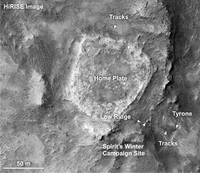Home Plate (Mars)
 HiRISE image of the "Home Plate" rock outcrop. | |
| Feature type | Rock outcrop |
|---|---|
| Coordinates | 14°36′S 175°30′E / 14.6°S 175.5°E |
Home Plate is a plateau roughly 90 m across within the Columbia Hills, Mars. It is informally named for its similarity in shape to a baseball home plate. Home Plate is a rocky outcrop that appears to show layered features.
The plateau has been extensively studied by Spirit, one of the Mars Exploration Rovers, since 2006. The rover became stuck in loose granular material alongside the northeast side of the plateau. The rover last communicated with Earth on March 22, 2010.[1]
Exploration
[edit]Spirit arrived at Home Plate on sol 744 (February 7, 2006) and has completed a scientific investigation with her robotic arm before moving to Low Ridge Haven due to power concerns. She returned on sol 1126 to resume those studies.
Spirit spent her third Martian winter on Home Plate's north edge.[2]
Origins
[edit]Scientists now believe that Home Plate is an explosive volcanic deposit. It is surrounded by deposits of basalt, which are believed to have exploded on contact with water. The presence of brine is further supported by the high concentration of chloride ions in the surrounding rocks. The presence of bomb sags (laminae typically found in beds of volcanish ash) seems to confirm this hypothesis.[3]
A patch of 90% pure opaline silicon dioxide was unearthed by Spirit in the vicinity of Home Plate. The patch is believed to be formed in acidic hydrothermal conditions, which supports the theory that Home Plate is of an explosive volcanic origin. Water is also present as mineral hydrates.[4][5]
Since 2008, scientists believe that this formation is an example of an eroded, ancient, and extinct fumarole.[6]
Gallery
[edit]-
Spirit imager moves towards Home Plate.
-
Bomb sag
-
Curious rock, "animated" via wiggle stereoscopy.
See also
[edit]References
[edit]- ^ "Spirit Remains Silent at Troy". Archived from the original on November 24, 2012. Retrieved April 21, 2012.
- ^ Maggie McKee. "Mars rover Spirit to head north for the winter". Retrieved December 26, 2007.
- ^ Squyres, S.; Aharonson, O.; Clark, B.C.; Cohen, B. A.; Crumpler, L.; De Souza, P. A.; Farrand, W. H.; Gellert, R.; Grant, J.; Grotzinger, J. P.; Haldemann, A. F. C.; Johnson, J. R.; Klingelhofer, G.; Lewis, K. W.; Li, R.; McCoy, T.; McEwen, A. S.; McSween, H. Y.; Ming, D. W.; Moore, J. M.; Morris, R. V.; Parker, T. J.; Rice, J. W.; Ruff, S.; Schmidt, M.; Schroder, C.; Soderblom, L. A.; Yen, A. (2007). "Pyroclastic Activity at Home Plate in Gusev Crater, Mars" (PDF). Science. 316 (5825): 738–742. Bibcode:2007Sci...316..738S. doi:10.1126/science.1139045. hdl:2060/20070016011. PMID 17478719. S2CID 9687521.
- ^ "Mars Rover Spirit Unearths Surprise Evidence of Wetter Past". Archived from the original on March 8, 2013. Retrieved May 30, 2007.
- ^ Squyres, SW; Arvidson, RE; Ruff, S; Gellert, R; Morris, RV; Ming, DW; Crumpler, L; Farmer, JD; et al. (2008). "Detection of Silica-Rich Deposits on Mars". Science. 320 (5879): 1063–1067. Bibcode:2008Sci...320.1063S. doi:10.1126/science.1155429. PMID 18497295. S2CID 5228900.
- ^ Morris, R. V.; Ming, D. W.; Gellert, R.; Yen, A. S.; Clark, B. C.; Graff, T. G.; Arvidson, R. E.; Squyres, S. W.; Athena; CRISM Science Teams (2008). "The Hydrothermal System at Home Plate in Gusev Crater, Mars: Formation of High Silica Material by Acid-Sulfate Alteration of Basalt". Lunar and Planetary Science. 39: 2208. Bibcode:2008LPI....39.2208M.
External links
[edit]- Nasa's Mars Exploration Program
- Current position of the Mars rovers - Home Plate is visible, with Spirit's journey around it.
- The Planetary Society Weblog: Home, Sweet Home for Spirit Archived 2006-02-15 at the Wayback Machine
- Official Mars Rovers site




